#mori hirotaka
Explore tagged Tumblr posts
Text
Heavenly Delusion Episode 12: Outside of The Outside

One episode away from the end of the season. It's really something to realize that. One more episode left in this series, for now. And there's still a mountain of questions and curiosities and mysteries and foreshadowing and symbolism. And I'd love to go over it all that rests within this episode.
So, for the uninitiated, a degree of foresight exists within essentially all the children of Takahara academy. An ability to sense the future rather than see it, and interestingly enough this is the first time that it appears with Tokio, as we start off in a dream of hers. I like the unsettling nature of it, how the students are all rather different in disposition to how they usually are, and how expressive the Miina terminal is. More than that though, I'm curious about the organization of the students. Most importantly, Kona isn't there. And alongside that, there's two halves to the students.
Could this be an answer of who all becomes a Hiruko? We know Mimihime is predisposed to it, and we know that Kuku most likely becomes the fish Hiruko we saw early on. Similarly, with the info from the prior episode with the pairings, we know that either Taka or Anzu will become a Hiruko, but considering the side that each appears on, it would seem that it's Taka's fate to turn into a monster.

But within that, we get a potential contradiction as we awake from Tokio's dream. Mimihime and Shiro, and Anzu and Taka are sharing a lunch together talking about Tokio returning finally. Aside from the napkins of Taka and Shiro being a nice detail to reflect their personalities, it's Anzu and Mimihime here who are eating their sandwiches with those deep red tomatoes on them. You can't help but notice that Mimihime's tomatoes are spilling out though, while Anzu's remain intact. Mimihime's are more symbolism for the inability to remain untouched/whole, but I'm unsure of the purpose of Anzu's.

Anyways, that sandwich is used once again rather quickly, and ties in quite well to the overall story of this episode. Takahara academy comes under attack, and the group must run to safety as the entire facility begins to panic. This scene of Mimihime's sandwich being crushed under the debris though paints a pretty clear picture. If Mimihime's bite allowed for no return, the destruction of the sandwich clearly sends an even stronger version of the message. Whether it's to Mimihime becoming a Hiruko, or the destruction and change of her life through this episode, it is an irreversible change that shakes the foundations of her life.

As destruction rains down on Takahara Academy however, we're returned to Kiruko and Maru as the former places the Ibaraki facility in their sights. I really love how they open this sequence with Kiruko pushed to the far right of the frame to show her determination for moving on, while Maru's hand occupies the left as a belt slips from his grasp, showing how he's losing Kiruko to her past.
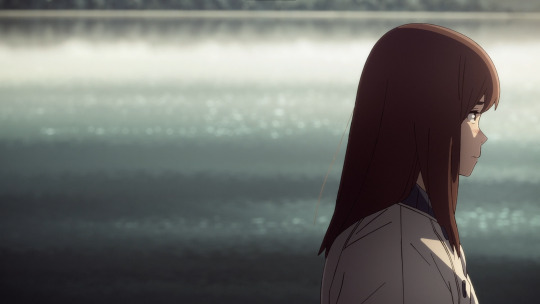

Following this, we get into the meat and potatoes of the episode, as the pair explore the town that's appeared around the Ibaraki facility. This is all incredibly fresh in my mind as I'd just read volume 5, so I'm only going to pick out the pieces that I think are important in terms of foreshadowing in the like, starting with their "chips", the form of local currency they use.
Simply put, it appears like a puzzle. The notches on the end of the wood all differ, and even the color of the wood itself changes. Similarly, there's not a single repeat color or pattern in the bunch. Immediately, the designs remind me of technology and the sort of branching out we see from Maru in the opening. There's absolutely something greater with these pieces of currency, but I can't find an answer as to how they should be pieced together.

Moving forward from this curiosity though, I love the direction with Kiruko as she finds out that Robin is here in this town. The use of her running scenes that appear from later on in the episode to show her desperation and desire are a great piece, and the fact that Maru isn't in those scenes only adds to how much distance the put between the pair as they return to their room for the evening. Really well done at naturally driving a stake between the duo.
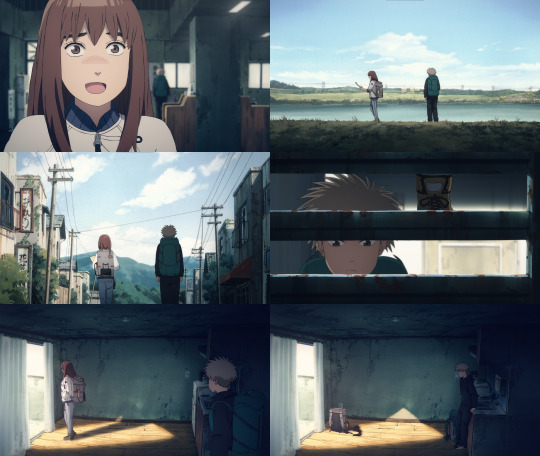
Following this separation, we get to the pieces of Kiruko running that we saw earlier on, as they make her way to the Ibaraki facility. It's a well done emotional moment that captures a lot of Haruki's emotions. I think it's an important distinction they make through it all, because Robin is only shocked to see Kiriko, as the episode uses the shadows to darken Kiruko's hair to make them appear more like Kiriko.
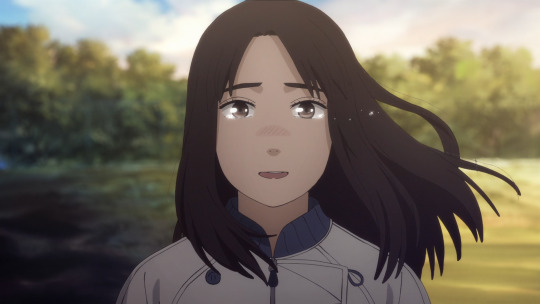
Of course, it wouldn't be Heavenly Delusion if we weren't jumping all over the map, so we return to the Takahara Academy as they panic amongst the destruction. It's neither here nor there, the director gets out of her wheelchair and runs for her life, which is funny, but it's not the takeaway. The scene that separates Kona from Mimihime, Shiro, Anzu, and Taka is.
They really like these balanced and separated shots through the episode. Placing Kona by himself with the younger students that flank him, and the group of four that goes off to investigate the wall, really makes you think about why they were placed like they were. Why the four students appeared in Tokio's dream, but not Kona. Given the ending of the episode, I have a real sinking suspicion about what fate Kona will meet while at the pool.

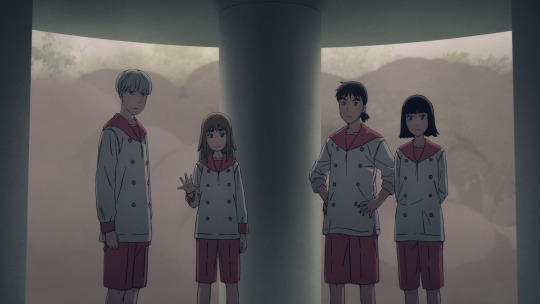
And just a quick little addition, we see where Maru gets his name from! Sawatari places a circle on the one child's foot so that he can discern which is which, and apparently that ends up sticking.
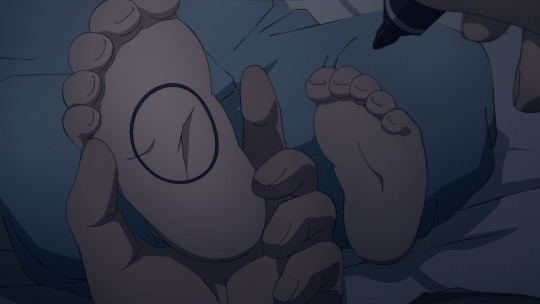
As quickly as we join Takahara academy, we leave just as the group of four set out to explore the hole in the wall, and return to Kiruko at the Ibaraki facility, where we get some more interesting pieces in regards to our logo. The first appears on what seems to be a plaque denoting this as the "Takahara Academy: Ibaraki Facility", while the second is found on an interesting sheet of paper titled "Natural Wealth Operation". I'm pretty sure people grasp that NWO can also be interpreted as "New World Order", which gives a glimpse into how the Academy operated under prying eyes.

Regardless, both of which sport a different logo to the Kiru Beam. The bird is more upright/vertical in the above images, with the smaller circle being full and lower within the larger circle when compared to the logo that Kiruko and Maru have been carrying around.

This paints an interesting and curious picture. How old is the Ibaraki Facility? Was it being used prior to the collapse/apocalyptic event? Is it possible that the Ibaraki facility was foresaken prior to the current state of the Takahara Academy? I think it's entirely possible, considering what it is that Robin claims to have found within. Considering the "current" standpoint of creating immortal bodies for people to swap into, it's pretty well removed from work with plants and agriculture.
Anyways, the episode begins to reveal Robin's sinister side as we come back to the students that made it outside of the outside, through the hole in the wall they saw. It's a really great piece, and is used well in opposition to Kiruko's situation (side note: I'm not a massive fan of it, so I'm hoping the next episode better contextualizes the purpose for her trauma here). That is, the children have found a way to indescribable freedom, while Kiruko is trapped and locked away due to Robin.
What further ties these two together though is those tomatoes. The ones the children worked so hard to cultivate. Those spotless and pure tomatoes that exist within the academy. That begin to get cut open, to bleed. To irreversibly become damaged and forever changed.
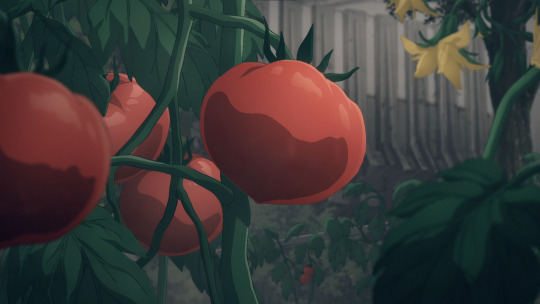
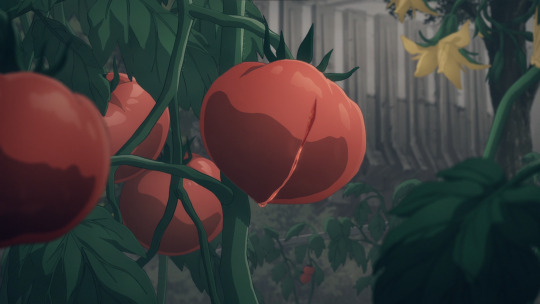
If this episode didn't make it clear, it's all about the convergence of our two timelines, not in terms of chronology or order of events per se, but rather their experience. Bringing each to their climax, finding different things waiting for them and creating stories that serve to oppose one another as we come ever closer to understanding what it is that's going on.
The direction remains stellar, storyboarding is incredible, the original scenes (that I know of) work amazingly well, the animation is top notch, the characters are outstanding. It's all the praise I've ever had for the series, appearing once more like it's nothing but another Saturday. I absolutely can't wait to see how we end this season with the next episode.
#heavenly delusion#tengoku daimakyou#天国大魔境#production i.g#mori hirotaka#kiruko#maru#anime recommendation#anime review#horror anime#anime and manga#anime
71 notes
·
View notes
Text



“It’s not scary, now that I know how it works.”
Heavenly Delusion | 天国大魔境, 2023
#heavenly delusion#tengoku daimakyou#天国大魔境#hirotaka mori#kensuke ushio#production i.g#masakazu ishiguro#post apocalypse#science fiction#seinen
15 notes
·
View notes
Text
#anime#animation#sakuga#tengoku daimakyou#hirotaka mori#kazuya nomura#tetsuya takeuchi#ryo araki#weilin zhang#yuji kaneko#shuto enomoto#masakazu ishiguro#heavenly delusion
22 notes
·
View notes
Text
Heavenly Delusion (Season 1)
Heavenly Delusion (2023) What Is It? The 2023 Japanese mystery science fiction adventure anime (animated) TV show Heavenly Delusion (Season 1). Tengoku Daimakyo | Official Trailer | Disney+ Singapore Description by The IMDb: In the outside world, 15 years have passed since an unprecedented disaster, that completely destroyed modern civilization. A group of children live in a facility…

View On WordPress
#Anime#Heaven#Heavenly Delusion#Heavenly Delusion Season 1#Hell#Hirotaka Mori#Japanese#Kensuke Ushio#Makoto Fukami#Man-Eater#Production I.G#Review#Tengoku Daimakyou#天国大魔境
1 note
·
View note
Text
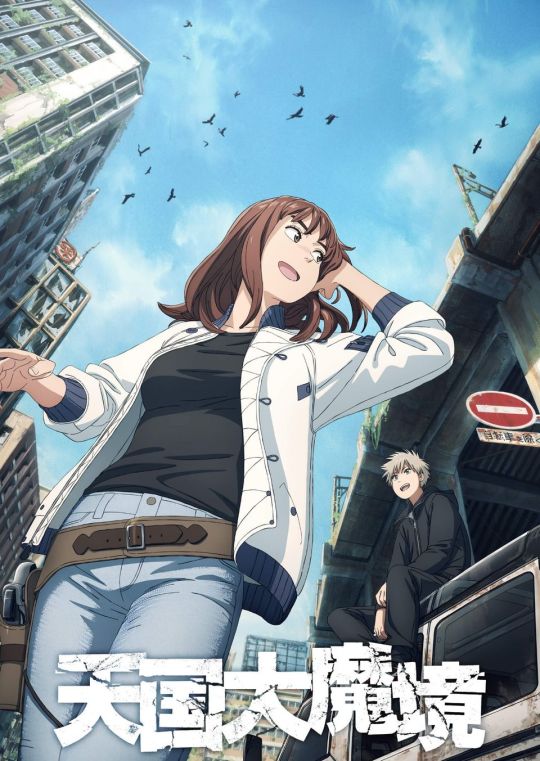
天国大魔境 (Tengoku Daimakyou) (O Paraíso Ilusório) - Hirotaka Mori - 2023. ★★★☆
31 notes
·
View notes
Text
2024 olympics Japan roster
Archery
Nakanishi Junya (Okayama)
Saito Fumiya (Gifu Ichi)
Furukawa Takaharu (Aomari Ichi)
Noda Satsuki (Kitakyushu)
Athletics
Higashida Akihiro (Nara)
Ota Tomoki (Hamamatsu)
Kasai Jun (Aichi)
Ogawa Daiki (Shizuoka)
Koyama Naoki (Saitama Ichi)
Hamanishi Ryo (Osaka)
Koga Yuta (Fukuoka)
Yamamoto Shouma (Osaka)
Nishi Yudai (Tokyo)
Yoshizu Takuho (Tokyo)
Takahashi Kazuki (Iwate)
Abdul Sani-Brown (Sakado)
Sakai Ryūichirō (Toyonaka)
Uzawa Towa (Miyagi)
Iizuka Shōta (Omaezaki)
Ueyama Koki (Matsusaka)
Satō Fūga (Tokyo)
Satō Kentarō (Tokorazawa)
Nakajika Yuki (Tokyo)
Izumiya Shunsuke (Yokohama)
Rachid Muratake (Matsuda)
Takayama Shun'ya (Hiroshima)
Tsutsue Kaito (Kumamoto)
Toyoda Ken (Tokyo)
Miura Ryūji (Hamada)
Aoki Ryōma (Kuki)
Akasaki Akira (Ōzu)
Ōsako Suguru (Machida)
Ikeda Kōki (Hamamatsu)
Kiryū Yoshihide (Hikone)
Yanagita Hiroki (Tokyo)
Kawabata Kaitō (Matsusaka)
Kawano Masatora (Hyūga)
Akamatsu Ryōichi (Gifu Ichi)
Shinno Tomohiro (Hiroshima)
Hashioka Yūki (Saitama)
Roderick Dean (Kobe)
Goshima Rino (Kanazawa)
Kokai Haruka (Myoko)
Morimoto Mariko (Osaka)
Tanaka Nozomi (Ono)
Goto Yume (Kakogawa)
Yamamoto Yuma (Nagoya)
Kabasawa Wakana (Maebashi)
Takashima Yuka (Hōfu)
Fukube Mako (Hiroshima)
Tanaka Yumi (Osaka)
Ichiyama Mao (Izumi)
Suzuki Yuka (Daisen)
Fujii Nanako (Nakagawa)
Okada Kumiko (Ageo)
Yanai Ayane (Fukuoka)
Hata Sumire (Yao)
Kitaguchi Haruka (Asahikawa)
Saitō Marina (Mito)
Ueda Momone (Itoshima)
Badminton
Kōdai Naraoka (Aomori Ichi)
Nishimoto Kenta (Ise)
Hoki Takurō (Yamaguchi Ichi)
Kobayashi Yūgo (Sendai)
Watanabe Yūta (Suginami)
Yamaguchi Akane (Katsuyama)
Ōhori Aya (Aizuwakamatsu)
Matsuyama Nami (Kitakyushu)
Shida Chiharu (Hachirōgata)
Matsumoto Mayu (Sapporo)
Nagahara Wakana (Akita Ichi)
Higashino Arisa (Iwamizawa)
Basketball
Yoshii Hirotaka (Osaka)
Togashi Yūki (Shibita)
Tajon Jacobs (Los Angeles, California)
Kawamura Yuki (Yanai)
Hiejima Makoto (Fukuoka)
Kai Toews (Kobe)
Hachimura Rui (Sendai)
Watanabe Yūta (Miki)
Yūdai Baba (Toyama Ichi)
Josh Hawkinson (Shoreline, Washington)
Keisei Tominaga (Tokyo)
Hugh Hogland-Watanabe (Honolulu, Hawaii)
Stephanie Mawuli (Nagoya)
Evelyn Mawuli (Nagoya)
Takada Maki (Toyohashi)
Yoshida Asami (Tokyo)
Machida Rui (Asahikawa)
Motohashi Nako (Asaka)
Yamamoto Mai (Hiroshima)
Hayashi Saki (Itoshima)
Miyazaki Saori (Saitama)
Miyazaki Yuki (Yokohama)
Todo Nanaka (Sapporo)
Akaho Himawari (Kanazawa)
Boxing
Harada Shudai (Tokyo)
Sewon Mensah-Okazawa (Kanoya)
Breakdancing
Ono Hiroto (Tokyo)
Nakarai Shigeyuki (Sapporo)
Yuasa Ami (Kawaguchi)
Fukushima Ayumi (Kyoto)
Canoeing
Tanaka Yuuki (Tokyo)
Haneda Takuya (Toyota)
Okazaki Haruka (Tokyo)
Yazawa Aki (Iida)
Climbing
Narasaki Tomoa (Utsunomiya)
Anraku Sorato (Yachiyo)
Mori Ai (Mito)
Nonaka Mihō (Tokyo)
Cycling
Arashiro Yukiya (Ishigaki)
Ōta Kaiya (Okayama)
Obara Yuta (Hashikami)
Nakano Shinji (Hanamaki)
Nagasako Yoshitaku (Kasaoka)
Imamura Shunsuke (Ukiha)
Hashimoto Eiya (Gifu Ichi)
Kuboki Kazushige (Furudono)
Nakamura Rimu (Kyoto)
Kawaguchi Urara (Hyogo)
Yonamine Eri (Osaka)
Sato Mina (Chigasaki)
Ōhta Riyu (Ageo)
Kakita Maho (Kitakyushu)
Ikeda Mizuki (Ōnojō)
Uchino Tsuyaka (Fukuoka)
Kajihara Yūmi (Saitama Ichi)
Hatakeyama Sae (Yokohama)
Diving
Shō Sakai (Sagamihara)
Tamai Rikuto (Takarazuka)
Mikami Sayaka (Yonaga)
Enomoto Haruka (Utsunomiya)
Arai Matsuri (Itami)
Equestrian
Kawai Mike (Valkenswaard, The Netherlands)
Ōiwa Yoshiaki (Münsingen, Germany)
Tomoto Kazuma (Motosu)
Kitajima Ryūzō (Kobe)
Tanaka Toshiyuki (Fukuoka)
Shibayama Haase-Takashi (Kobe)
Satō Eiken (Ogawa)
Sugitani Taizō (Izumi)
Fencing
Kanō Kōki (Ama)
Minobe Kazuyasu (Echizen)
Yamada Masaru (Toba)
Iimura Kazuki (Kyoto)
Matsuyama Kyōsuke (Tokyo)
Shikine Takahiro (Ōita Ichi)
Nagano Yūdai (Ibaraki)
Yoshida Kento (Morioka)
Yoshimura Miho (Tokyo)
Azuma Sera (Wakayama Ichi)
Miyawaki Karin (Tokyo)
Ueno Yūka (Hita)
Emura Misaki (Ōita Ichi)
Fukushima Shihomi (Munakata)
Takashima Risa (Ōmuta)
Ozaki Seri (Sapporo)
Field hockey
Nakamura Eika (Tochigi)
Asai Yū (Hiroshima)
Suzuki Miyu (Gifu Ichi)
Nagai Yuri (Kakamigahara)
Nagai Hazuki (Kakamigahara)
Oikawa Shihori (Tokyo)
Kozuka Miki (Nikko)
Kobayakawa Shiho (Matsue)
Mori Kanon (Hiroshima)
Toriyama Mai (Tokyo)
Tanaka Saki (Morika)
Urata Kana (Osaka)
Shimada Amiru (Ōtsu)
Omoto Sakurako (Iwakuni)
Hasegawa Miyu (Matsue)
Ogawa Rika (Gifu Ichi)
Golf
Matsuyama Hideki (Sendai)
Nakajima Keita (Saitama Ichi)
Yamashita Miyū (Neyagawa)
Sasō Yūka (San Ildefonso, The Philippines)
Gymnastics
Hashimoto Daiki (Chiba Ichi)
Kazuma Kaya (Funabashi)
Oka Shinnosuke (Kamakura Ichi)
Sugino Takaaki (Kamakura Ichi)
Tanigawa Wataru (Funabashi)
Nishioka Ryusei (Higashiosaka)
Kishi Rina (Toda)
Nakamura Haruka (Osaka)
Okamura Mana (Yokkaichi)
Ushioku Kohane (Nagoya)
Mori Hikaru (Tokyo)
Handball
Nakamura Takumi (Fukuoka Ichi)
Yasuhira Kosuke (Takaoka)
Sakurai Tomoya (Mito)
Okomoto Daisuke (Yamaguchi)
Fujisaka Naoki (Fukui)
Takano Sota (Tokyo)
Sugioka Naoki (Kariya)
Yoshida Shūichi (Wakayama Ichi)
Adam Baig (Fukuoka Ichi)
Tokuda Shinnosuke (Iwakuni)
Watanabe Jin (Ōita)
Motoki Shida (Mito)
Tamakawa Hiroyasu (Tokyo)
Yoshino Tatsuki (Misato)
Judo
Nagayama Ryuju (Bibai)
Abe Hifumi (Kobe)
Hashimoto Soichi (Tokyo)
Nagase Takanori (Mito)
Murao Sanshirō (Tokyo)
Aaron Wolf (Tokyo)
Saito Tatsuru (Osaka)
Tsunoda Natsumi (Yachiyo)
Abe Uta (Kobe)
Funakobu Haruka (Fujiyoshida)
Tashiro Takaichi (Tokyo)
Niizoe Saki (Kashihara)
Takayama Rika (Tokyo)
Sone Akira (Kurume)
Pentathlon
Satō Taishū (Aomori Ichi)
Uchida Misaki (Kumagaya)
Rowing
Furutu Naoki (Tottori)
Miyaura Masayuki (Mito)
Arakawa Ryūta (Yokohama)
Hirouchi Emi (Kyoto)
Ōishi Ayama (Nagoya)
Rugby
Ishida Taiga (Kumamoto)
Ishida Kippei (Amagasaki)
Tsuoka Shotaro (Fukuoka Ichi)
Matsumoto Junya (Kagoshima)
Josua Kerevi (Viseisei, Fiji)
Fukushi Moeki (Hyogo)
Taninaka Kippei (Hyogo)
Noguchi Yoshihiro (Tokyo)
Ueda Kazuma (Hyogo)
Maruo Takamasa (Tokyo)
Okudaira Yu (Hyogo)
Koga Yoshiyuki (Tokyo)
Yoshizawa Taichi (Tokyo)
Utsumi Hanako (Yokohama)
Ōtani Mei (Kyoto)
Kajiki Marin (Fukuoka Ichi)
Saegusa Chiaki (Sapporo)
Tanaka Emii (Uozu Ichi)
Tsutsumi Honoka (Ureshino)
Nakamura Chiharu (Yokohama)
Nishi Arisa (Tokyo)
Hara Wakaba (Niigata Ichi)
Hirano Yume (Tokyo)
Matsuda Rinka (Fuchu)
Mizutani Sakura (Mie)
Sailing
Tomizawa Makoto (Kashiwazaki)
Okada Keiju (Kitakyushu)
Iitsuka Shibuki (Yokohama)
Tanaka Misaki (Higashiura)
Nagamatsu Sera (Ōita Ichi)
Oura Nishida-Capiglia (Mie)
Yoshioka Miho (Fujisawa)
Shooting
Okada Naoya (Tsuyama)
Yoshioka Dai (Kyoto)
Nobata Misaki (Ōita Ichi)
Skateboarding
Nagahara Yuro (Hakuba)
Onodero Gin'u (Yokohama)
Shirai Sora (Sagamihara)
Horigome Yūto (Tokyo)
Hiraki Kokona (Tomakomai)
Yosozumi Sakura (Iwade)
Kusaki Hinano (Tsukuba)
Yoshizawa Koko (Sagamihara)
Akama Rizu (Sendai)
Nakayama Fūna (Toyama Ichi)
Soccer
Leo Kokuba (Chiba Ichi)
Suzuki Kaito (Shizuoka Ichi)
Nishio Ryūya (Osaka)
Sekine Hiroki (Shizuoka Ichi)
Kimura Seiji (Chiba Ichi)
Kawasaki Sota (Kōfu)
Yamamoto Rihito (Yokohama)
Joel Chima-Fujita (Tokyo)
Fujio Shota (Osaka)
Saitō Kōki (Tokyo)
Hosoya Mao (Ushiku)
Nozawa Taishi (Naha)
Araki Ryotaro (Kumamoto Ichi)
Mito Shunsuke (Yamaguchi Ichi)
Takai Kota (Yokohama)
Ōhata Ayumu (Fukuoka Ichi)
Hirakawa Yu (Kashima)
Keiji Sato (Tokyo)
Uenaka Asahi (Fukuoka Ichi)
Yamada Fuki (Minakuchi)
Uchino Takashi (Chiba Ichi)
Yamashita Ayaka (Tokyo)
Hirao Chika (Matsudo)
Shimizu Risa (Kobe)
Minami Moeka (Yoshikawa)
Kumagai Saki (Sapporo)
Takahashi Hana (Kawaguchi)
Tōko Koga (Osaka)
Kitagawa Hikaru (Kanazawa)
Hasegawa Yui (Sendai)
Miyazawa Hinata (Minamiashigara)
Seike Kiko (Tokyo)
Nagano Fūka (Tokyo)
Momoko Tanikawa (Nagoya)
Fujino Aoba (Machida)
Hayashi Honoka (Uji)
Ueki Riko (Kawasaki)
Tanaka Mina (Kawasaki)
Hamano Maika (Takaishi)
Shū Ohba (Fujisawa)
Moriya Miyabi (Nara Ichi)
Ishikawa Rion (Akita Ichi)
Chiba Remina (Tsukuba)
Surfing
Inaba Reo (Ichinomiya)
Connor O'Leary (Cronulla, Australia)
Kanoa Igrashi (Huntington Beach, California)
Matsuda Shino (Yokohama)
Swimming
Matsuyama Riku (Saitama Ichi)
Takehara Hidekazu (Munekata)
Taniguchi Taku (Hyogo)
Terakado Genki (Mito)
Murasa Tatsuya (Nagoya)
Mano Hidenari (Yokohama)
Matsumoto Riku (Tokyo)
Minamide Taishin (Kainan)
Matsumoto Katsuhiro (Iwaki)
Watanabe Ippei (Tsukumi)
Hanaguruma Yu (Sakaide)
Mizunuma Naoki (Moka)
Honda Tomoru (Yokohama)
Seto Daiya (Moroyama)
Matsushita Tomoyuki (Utsonomiya)
Kanagimoto Kōnosuke (Imari)
Higa Moe (Hiroshima)
Kobayashi Uta (Nagano)
Shimada Ayano (Mie)
Wada Ami (Nagano)
Yasunaga Mashiro (Tochigi)
Sato Tomoka (Tsukuba)
Kijima Moeka (Hakusan)
Yoshida Megumu (Nagoya)
Ebina Airi (Sapporo)
Matsumoto Shiho (Shizuoka Ichi)
Hirai Mizuki (Kariya)
Ikee Rikako (Tokyo)
Suzuki Satomi (Onga)
Aoki Reona (Tokyo)
Tanigawa Ageha (Osaka)
Narita Mio (Tokyo)
Kobori Waka (Nara Ichi)
Mitsui Airi (Yokohama)
Makino Hiroko (Tokyo)
Ōhashi Yui (Hikone)
Igarashi Chihiro (Yokohama)
Shirai Rio (Takarazuka)
Ikemoto Nagisa (Nara Ichi)
Masuda Aoi (Kurashiki)
Table tennis
Shinozuka Hiroto (Nagoya)
Harimoto Tomokazu (Sendai)
Togami Shunsuke (Tsu)
Hayata Hina (Kitakyushu)
Hirano Miu (Numazu)
Harimoto Miwa (Sendai)
Tennis
Nishikori Kei (Bradenton, Florida)
Taro Daniel (Bradenton, Florida)
Naomi Osaka (Los Angeles, California)
Uchijima Moyuka (Kuala Lumpur, Malaysia)
Aoyama Shūko (Osaka)
Ena Shibahara (Rancho Palos Verdes, California)
Triathlon
Kenji Nener (Perth, Australia)
Odakura Makoto (Tokyo)
Takahashi Yūko (Mitaka)
Volleyball
Nishida Yūji (Inabe)
Ōnodera Taishi (Natori Ichi)
Fukatsu Akihiro (Hiroshima)
Miyaura Kento (Kumamoto Ichi)
Ōtsuka Tatsunori (Osaka)
Yamauchi Akihiro (Aichi Ichi)
Sekita Masahiro (Tokyo)
Takahashi Kentarō (Yamagata)
Takahashi Ran (Kyoto)
Yūki Ishikawa (Okazaki)
Kai Masato (Tokyo)
Yamamoto Tomohiro (Ebetsu)
Uchida Akiko (Tokyo)
Ishii Miki (Fujisawa)
Kojima Manami (Sendai)
Fukudome Satomi (Tokyo)
Araki Ayaka (Tokyo)
Wada Yukiko (Tokyo)
Tominaga Koyomi (Komae)
Hayashi Kotona (Osaka)
Sarina Koga (Saga Ichi)
Mayu Ishikawa (Okazaki)
Nanami Seki (Funabashi)
Inoue Arisa (Maizuru)
Nichika Yamada (Nagoya)
Miyabe Airi (Kobe)
Water polo
Watanabe Taiyo (Kyoto)
Ogihara Daichi (Kagoshima)
Kai Inoue (Los Angeles, California)
Date Kiyomu (Osaka)
Nitta Ikkei (Kanazawa)
Nishimura Towa (Kyoto)
Tanamura Katsuyuki (Ishigaki)
Adachi Seiya (Kakamigahara)
Suzuki Toi (Yamagata)
Takata Mitsuru (Hiroshima)
Inaba Yūsuke (Toyama)
Ōkawa Keigo (Tsuchiura)
Araki Kenta (Fukuoka Ichi)
Weightlifting
Miyamoto Masanori (Naha)
Murakami Eishiro (Toyama Ichi)
Suzuki Rira (Shiroi)
Wrestling
Sogabe Kyotaro (Matsuyama)
Higuchi Rei (Ibaraki Ichi)
Kiyooka Kotaro (Kōchi Ichi)
Takatani Daichi (Kyōtango)
Ishiguru Hayato (Tokyo)
Fumita Ken'ichirō (Kōfu)
Kusaka Nao (Takamatsu)
Susaki Yui (Matsudo)
Fujinami Akari (Yokkaichi)
Sakurai Tsugumi (Kōchi Ichi)
Motoki Sakura (Saitama Ichi)
Ozaki Nonoka (Tokyo)
Kagami Yuka (Yamagata Ichi)
#Sports#National Teams#Japan#Celebrities#Races#Basketball#Washington#Hawaii#Fights#Boxing#Boats#Animals#The Netherlands#Germany#Hockey#Golf#Fiji#Soccer#Australia#Tennis#Florida#Malaysia#The Philippines
3 notes
·
View notes
Text
Let's Read: A Requiem for Char: The Red Comet of My Youth - Chapter 4
by Shūichi Ikeda

This post will be an overview of the third chapter, Friends Connected by Gundam. Below are links to the previous chapters.
Chapter 1 | Chapter 2 | Chapter 3
In this chapter, Ikeda discusses his relationships with some of his fellow voice actors while recording Mobile Suit Gundam. This includes Tōru Furuya (Amuro), Fuyumi Shiraishi (Mirai), Hirotaka Suzuoki (Bright), Katsuji Mori (Garma), and Keiko Han (Lalah)

He begins with Tōru Furuya, the voice of Char’s eternal rival, Amuro Ray. Ikeda recalls how they didn’t talk much at first outside of the studio, one of the main reasons being that Furuya didn’t drink at the time.
Interestingly, he comments how that early distance between them actually was a benefit to the work.






Ikeda: In the scene where Char and Amuro meet for the first time, there is a contrast between the tense Amuro and Char's relaxed attitude, and I think this scene also utilized the tension of the time in a positive way. Toru-chan and I's actual relationship certainly resembled the relationship between Amuro and Char.
He continues by discussing the recording of Zeta: A New Translation.
Ikeda: It has been 20 years since I first performed in the Mobile Suit Z Gundam series, but when I stand in front of the microphone with Toru-chan, the atmosphere of those days mysteriously comes back to me. Without any discussion, the relationship between Amuro and Char immediately returns. I am happy to see that Toru-chan is still in good health, and that he has not changed at all.

Finally, a bit of a humorous note at the end - while Furuya didn’t drink during the time he was recording Gundam, he began doing so within the past ten years (as of this book's writing in 2007), to the point where he even surpassed Ikeda in alcohol tolerance.
In Ikeda’s words, “I never thought I would lose to Amuro-kun in such a way.”

Next, Fuyumi Shiraishi, the voice of Mirai Yashima. Ikeda had acted alongside her in Invincible Steel Man Daitarn 3 and was honored to have the opportunity to do so again for Gundam.


He mentions how, despite how often Director Tomino would come in with specific requests on how to perform a scene, the two never clashed, and Shiraishi would just respond with a cute “oka~y!”. However, Ikeda believes she gave priority to her own inspiration for the role.
Ikeda describes Shiraishi as a “cute younger sister-like older sister”, despite being one of the senior members of the cast at the time. He fondly remembers her as a great senior who was bright and playful and always kept the studio in a good mood.

Now Hirotaka Suzuoki, voice of Bright Noa, and also the voice of the main character (Banjou Haran) from Invincible Steel Man Daitarn 3, which is where he and Ikeda became friends.


Ikeda explains that while he didn’t often like drinking with people his own age, Suzuoki was different. While it's easy to complain, whine, and lick each other's wounds at drinking parties with people of the same generation, Suzuoki never did so. In his words, "He drinks with I, a man of the Zeon army while serving in the Federation. For the two of us, it didn’t matter whether it was Zeon or the Federation."
On a night drinking after the recording of Zeta: A New Translation, Ikeda remembers saying to him,
"You (Suzuoki) can't go first. I (Ikeda) am two months older than you, so keep your turn."
In reference to the fact both had grieved together for the passing of Yō Inoue (voice of Sayla Mass), a few years earlier. Tragically Suzuoki passed away in 2006, a year before this book’s publication.

Next, Katsuji Mori, the voice of Garma Zabi. He and Ikeda actually met many years before the recording for Gundam while both were still in junior high school and co-stars on a TV drama written by Genzō Murakami. Mori was already a star in the anime world thanks to his roles as Gou Mifune in Speed Racer and Ken Washio in Science Ninja Team Gatchaman.
"Why is Shu-chan Char? (Laughs)" "Why is Mori-san Garma? (Laughs)"
He remembers they had such an interaction upon seeing each other again.



Ikeda: I am sure Mori-san did not expect to be told by me, a younger man whom he has known since he was a child actor, that "he was a spoiled kid". He is a reliable "kid" who took care of me, who was unfamiliar with anime.

Finally, Keiko Han, the voice of Lalah Sune. Ikeda had worked with her in dubbing the overseas drama series Man from Atlantis and was excited to meet her again on the set of Gundam.




Ikeda: Han-san is a very unusual voice actor, and her tempo is slightly different from my performance. This created a mysterious atmosphere that flowed between Char and Lalah, and it made for an indescribably soft performance. We did not plan this beforehand, so the way they deviate from each other differs from time to time, but it gives the work a good flavor.
Outside of voice acting, Han is also an astrologer and authored many books on the subject. Among the voice actors, it is famous that her fortune telling is often correct.
“Ikeda-san, next year will be a good year for you.”
Ikeda: Han-san says this every time she sees me. I don't know if it is lip service or if she only tells me when my luck is good, but at any rate, my pragmatism and Han-san's ability to see beyond the mystical may be a surprisingly good match. At least when Han-san was asked to play the role of the lover, she seemed to be very compatible with my performance.
~
That's all for my summary of chapter 4. Thank you for reading!
12 notes
·
View notes
Text
youtube
Heavenly Delusion is one of my favorite ongoing mangas right now and to see the treatment it's getting here is absolutely amazing. Yuji Kaneko's background continues to be so spectacular. The contrast between the Heaven-like, bright green, utopia-tic world of the kids at the facility, versus the post-apocalyptic hell of our main characters outside (Kiruko and Maru), paired with Kentaro Waki's compositing creates a great cinematic vibe for every shot, and the stills look amazing. Waki has a great usage of blurring shots which can be seen in the trailer and it just works so well. The character designs by Utsushita match the manga's aesthetic perfectly. All of this of course helmed by director Mori Hirotaka who hasn't directed a full series before but has always been a very promising storyboarder and episode director known for his work in 86.
I don't know what else to say to get people to watch this show. It's genuinely one of the best-looking shows in April, as seen in the trailer, and people like me are raving about the story and characters. I hope you will give this story a chance.







20 notes
·
View notes
Text
youtube
▶️ HEAVENLY DELUSION: NUOVO TRAILER ANCHE PER UNA DELLE SERIE CHE PIÙ MI INCURIOSISCONO DELLA STAGIONE PRIMAVERILE!
L’adattamento dell’avventura sci-fi di Masakazu Ishiguro (Soredemo Machi wa Mawatteiru) è in mano al debuttante Hirotaka Mori e andrà in onda dal 1 aprile.
La licenza per lo streaming è andata a Disney+, ma ad ora non è chiaro se la serie verrà portata in simulcast.
#heavenly delusion#anime#serie tv#disney plus#disney+#streaming#manga#production i.g#trailer#news in the shell
0 notes
Text

9/28(土) Hirotaka Mori LiveTour~よるにこがれて~
開場18:00/開演19:00
料金 5000円(1ドリンク別)
出演:森広隆 Vo&gt /豊福勝幸 Bass /宮川剛 Dr
<予約>
3日以内にメール返信のない場合は、
電話053-485-9968(14:00~18:00:店休日を除く)にてご確認願います。
youtube
1 note
·
View note
Text
Heavenly Delusion Director Hirotaka Mori on Creating a Compelling End-Of-The-World Anime - Crunchyroll News
0 notes
Text
Heavenly Delusion Episode 13: The Journey Continues And Begins

Like many, this wasn't the final episode I was expecting from Heavenly Delusion, but it's an episode I'm really satisfied with. As a mystery series driven by character progression, it does an outstanding job of completing important character arcs while giving plenty of teasers as to what still lies ahead for them all. So, it's not anything grand or climactic, but it does an incredible job of capping off the incredibly strong season that it's given viewers, and I'd love to dive into that a little bit.
⚠️Warning: Discussion of Sexual Assault⚠️
The content discussed will not directly reference the actions, but the scene is built upon this act, so read at your own caution/risk if sensitive to these topics.
The episode starts off with Anzu, Taka, Mimihime, and Shiro walking around outside of the academy, believing it's still a part of the test. It's nothing special as it's mainly showing the children's curiosity at the scale of the world that exists outside of their confines.
What's more interesting, and mostly due to comedy and storyboarding, is Sawatari, Aoshima, et al's conversation about Tokio's child. Though they do a rather good job at presenting the idea that Tokio only had one child, and that the other is in fact a clone or some other genetically altered child. But anyways, I like the stretched perspective, and I like how they place the characters in it to isolate Sawatari and Aoshima during their monologues/speeches to increase that sense of anxiety thanks to the people present.
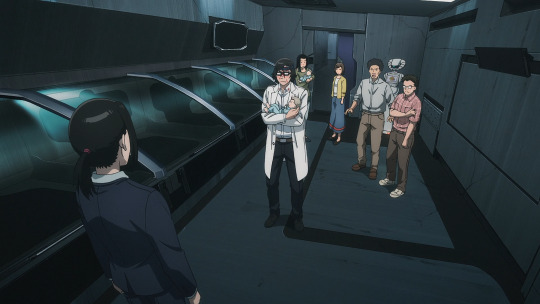
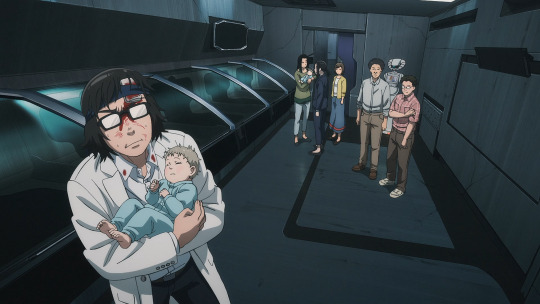
Following the waffling of this pair, we return to Maru who's left anxious and concerned about Kiruko not returning yet, which produces some really great scenes.
This part of the episode gets somewhat sketchy and stylized, as smearing is used very liberally throughout to further the feel of movement through the scene, and Maru's mission of finding Kiruko.
Here's just one example of that smearing. It's very strong and noticeable, but since it's used so much, it blends really well with the episode at large. Though being action heavy it also gives the episode plenty of opportunity to use it.
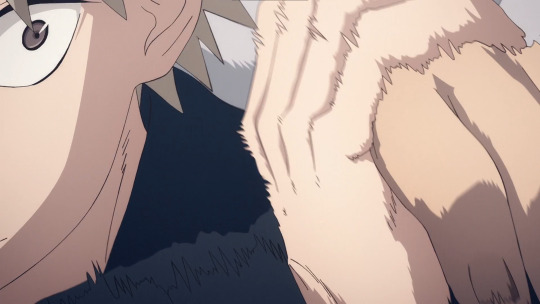
I think a more interesting example is the piece of Maru's shoes coming over top of the camera as he walks into the facility. Very easy to not smear here, but it adds a lot of feel to the very short cut, with the relative speed of Maru's foot as it comes right overtop of the camera being conveyed very well before the shoe properly comes into view and returns to being on model.
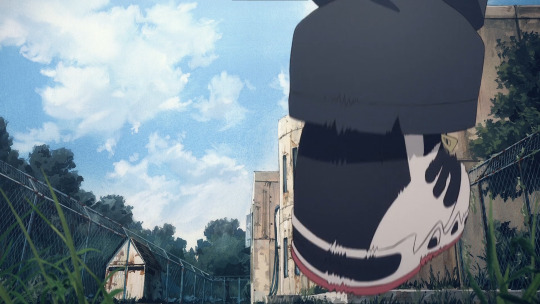
And then there's the combat, it does a great job of blending, and the direction works great in drawing out the best in the smears. We're not getting a look at this fight from a distance, but rather up close and personal, focusing on the specific pieces of it, so that smearing really helps with the perceived pace and strength of it all.
Also, I love how they approach the combat here. Whether it's tied to the overall idea of how Maru should fight, or if it's because he's seeing red, he's obviously outmatched by the challenger in this fight. The way he holds himself, and how he dodges and reacts. It's all very inhuman, which I think is a really great detail.
Now, for the hardest part of the episode, Kiruko. Truthfully, I think they do a good job with the scene. Not the best, given how it plays out in the end, but with all the pieces and possible outcomes, they convey a very candid and emotional experience that peers into Kiruko as a character.
So once more, content warning for this area, but I'll try to keep it as clean as I can.
We start this sequence with Kiruko beneath a spider's web, which is an unsurprising piece of symbolism to show how they're trapped in this situation.
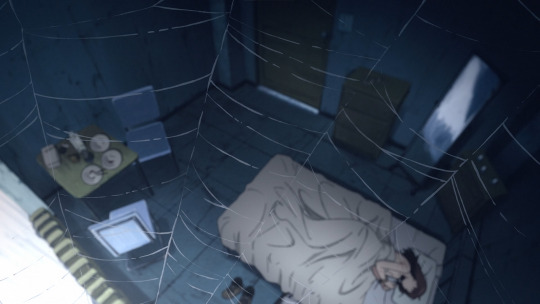
The imagery quickly changes though as Kiruko retreats further into themselves to find their big sister Kiriko, and a really great piece of symbolism occurs. Trapped in the body of their sister, a body which still retains memories of its past, Kiruko wants nothing but to be with their big sister. For Kiriko to return and say everything's going to be alright, that you'll be okay.
And it's also one of the first and only real pieces of Kiruko accepting their feminine body, as the bedsheets that hide Kiriko's body and separate it from Kiruko's mind turn into something akin to a pink and fluttering dress. For how terrible the act is, and how harsh it is to Kiruko, it does a surprising amount to push their character forward and allow them to face the identity crisis that they've been putting off this entire season.
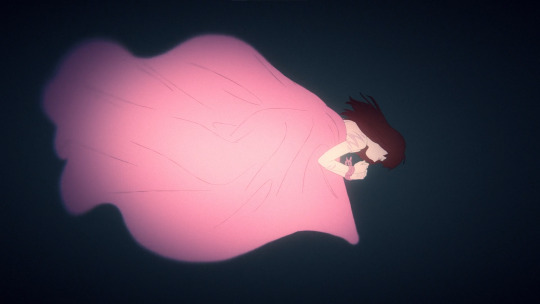
Though we don't linger all too long on this sequence as Maru finds Kiruko, and shortly after Robin stumbles into the picture as well. The following scene has two really big pieces that I think are crucial to our characters here.
The first is how Maru ignores Kiruko to go after Robin to make him pay. He leaves Kiruko vulnerable and alone in that room to hunt down the man who put her there in the first place, rather than helping and freeing Kiruko. It is the arguably incorrect choice to make in the situation, but it's very in line with Maru's character and so plays into the moment quite well.
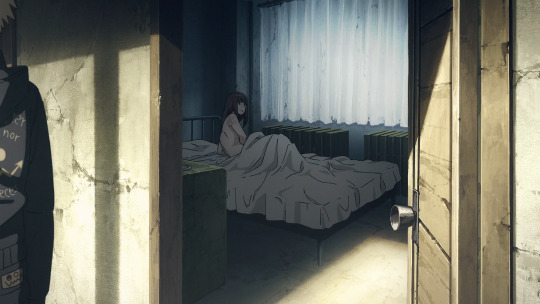
Then there's this one of Kiruko shortly after. Knowing that Maru's arrived, and that they'll be safe, Kiruko frees themselves. It's a bit of a terrible piece of symbolism for Kiruko's submission to Robin through these acts. That because of their past, because of the terrible things Robin's done to them, and the hatred they have for themselves, they further avoid the situation by remaining passive through it.
Now, they wouldn't have escaped in the first place thanks to the staff/guards, but there was nothing that was stopping from them attempting to flee in the first place, which is the important piece.
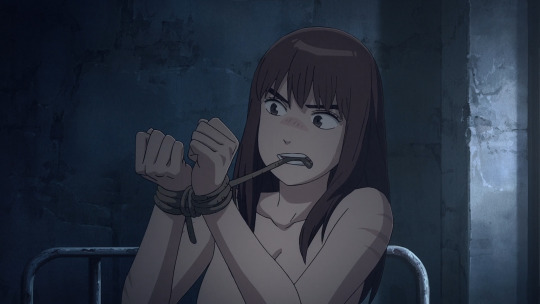
Anyways, in a cathartic moment for viewers and Maru, Maru nearly brings Robin's life to an end, but Kiruko stops them. Kiruko does the (sort of) right thing in this moment, but it's clear that the feelings and emotions tied to Haruki's childhood remain engrained in their mind and influence their decision.
What I really liked here though was the use of the theme of hands once more, making a call back to episode 8 with Maru's comment on how he only brings death and violence with them. I really really love their commitment to this overarching theme that appears through the season.
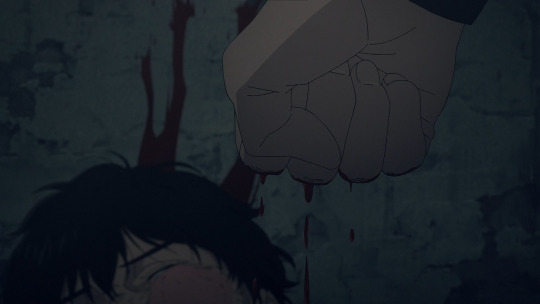
But, we don't stick with Robin and Maru for long, as we return to Tokio and Sawatari through the Noah Project. There's not a great deal of stuff to talk about here, other than Tokio's "ability", if you can call it that.
At a glance, it's cool, but I think if you dive deeper you get a lot more out of it. Tokio is the first of the Takahara Academy children to give birth. She's the first mother of these genetically engineered children for the sake of immortality. Her ability is awakened/used to protect her child, and encases the both of them (alongside the director) in some sort of protective layer almost. It's pretty clear that Tokio's ability is tied to her existence as a mother/parent, but I also think it's a sign or symbol of how the Hiruko came to exist. Tarao's died, and he's left behind that core, but we haven't seen anything about him turning into a Hiruko just yet, so there has to be a trigger that causes them to turn into Hiruko. So what if, and this is just a big if, Tokio's powers awakening/being used is the catalyst for the birth of Hiruko from these children to begin?
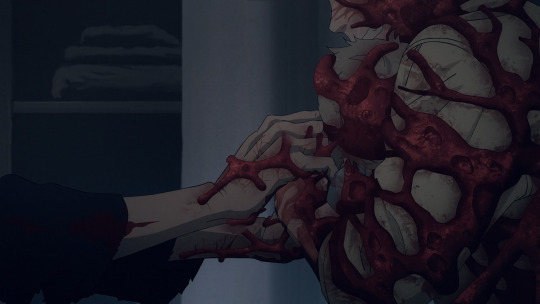
Of course, we don't find out in this episode what it is that's happening to Tokio, as we move onto Mimihime and Shiro who are trying to make their way back to the academy. Nothing of great importance to viewers that I want to pick apart, but I love how neatly they tie up the beginnings of romance between Mimihime and Shiro, with this really beautiful shot.
It's actually really cool, as the director of photography has been extensively chatting about it over on Twitter. Highly recommend checking out what they've got to say (in English!) about the moment.
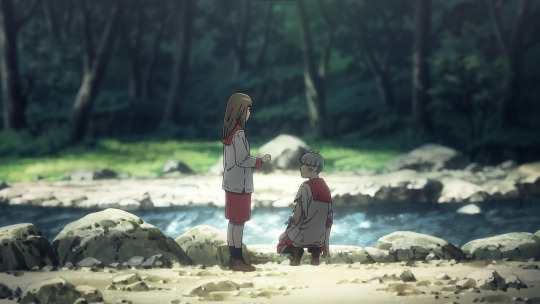
And back to the future, for the rest of the episode basically. We find Kiruko perched at the edge of the river with Maru waiting behind her. This is the part that I find a bit of trouble with, as Kiruko says a lot of important stuff in her monologue about their childhood and the challenges of coming face to face with the reality of the situation and having that dreamy past to look back on come crashing down. But Maru ends up talking about how he loves Kiruko. And don't get me wrong, the idea of sharing love and cementing Kiruko as their own person that's separate from Haruki and Kiriko is important, and I really admire that piece of Maru's speech. But I think conveying it as a romantic love puts a stain on what's just happened. Yeah, I do know that not everything will be perfectly displayed by fictional characters that aren't perfect, but I also feel that if you're going to include those more terrible aspects in your work, that you need to fairly and properly address them, and mixing romance into a heartfelt moment that builds upon those darker pieces doesn't feel like the best thing to do.
Anyways, here's a nice piece of symbolism of Kiruko feeling alone in the world now that she's seen who Robin really is, and how he was only ever looking at Kiriko, and how after Maru's speech of accepting and loving Kiruko, she feels like she has someone in this world to lean on. Really endearing piece that finalizes the bond this pair have shared since the start of the story.
Similarly, the shift in colors is a really nice touch as well. The first image is very gray, dim, and dull, while the second is far more vibrant and colorful. Reflects Kiruko's emotions and mental state quite well, in my opinion.
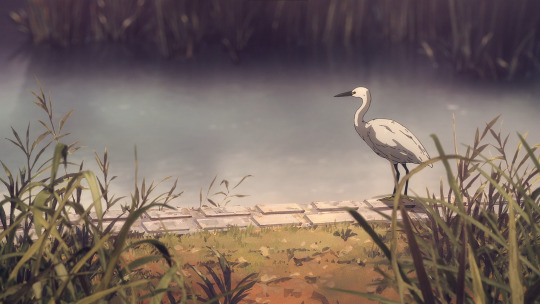
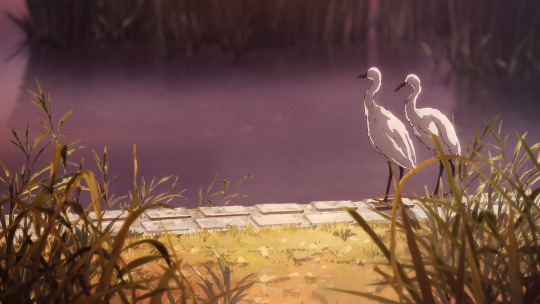
Now, the episode may be on its way to finishing, but that doesn't mean that this story is over. No, there's far more mysteries and curiosities to it, starting with the locked door Robin was trying to get into.
That's right, a monster. Not a Hiruko though. Think back. Carefully consider the pieces that we've seen through this season so far. There's not been a single Hiruko with black skin. They've all been white, and had discernable eyes/features that mimic prior aspects of themselves. This.... thing has none of them and is directly linked to the dismembered person next to it. Could it have something to do with the plant studies they found in this building? Could it be Robin's own attempt at a Hiruko? I'm unsure, but it opens the door to a new atrocity.
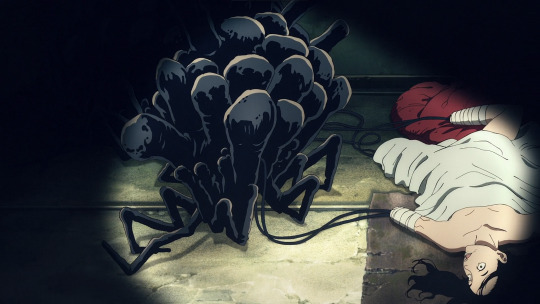
Similarly, at the very end of the episode, we see a slightly older foursome of Anzu, Taka, Shiro, and Mimihime being taken to shore. This confirms that the Takahara Academy we know of is on an island, and that in "saving" these children, they're effectively introducing the Hiruko to the mainland.
What I find interesting with this is that it introduces a max of two Hiruko, in Taka and Anzu, but we also know that this isn't true. Only one out a pair of children will become a Hiruko in the way that we know them, and we know that Shiro helps stave off Mimihime's transformation. Because of that, we have a maximum of a single transformation between Taka and Anzu, which definitely doesn't account for all of the Hiruko that we know of. Considering the fact that these Hiruko are based around the abilities of the children themselves, we know that at some point, characters like Kuku and maybe Ohma (? Forget if it's been confirmed that they're the Hiruko from the underground garage) make their way across to the mainland at some point or another.
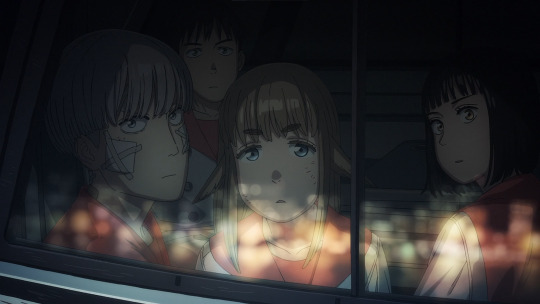
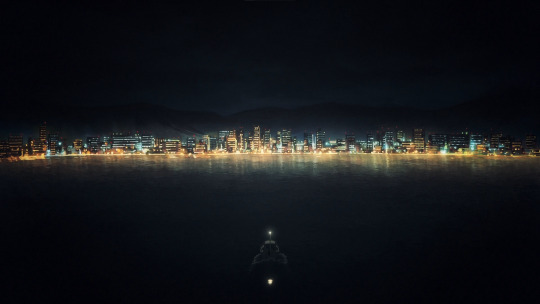
And with that, the season comes to a close. It's not an 11/10 episode that knocks your socks off with crazy revelations or curtains being drawn open, but I absolutely think it's still deserving of praise for how well it closes out several character arcs while continuing to expand the world that our two eras of characters explore. Endless mystery and oddity continue to unravel from the incredible tapestry that Hirotaka and Ishiguro have woven together through this story and its adaptation. I'm incredibly hopeful for a second season in the future, but I also hope that they take all the time in the world to produce it, especially as the anime is hot on the heels of the manga, which provides incredible opportunity for tighter cooperation on the material.
And if my statement wasn't clear in this episode or the previous, Heavenly Delusion is absolutely the crown jewel of this season, and the frontrunner for the standout anime of this entire year.
#heavenly delusion#tengoku daimakyou#天国大魔境#production i.g#mori hirotaka#kiruko#maru#anime recommendation#anime review#horror anime#anime and manga#anime
62 notes
·
View notes
Text
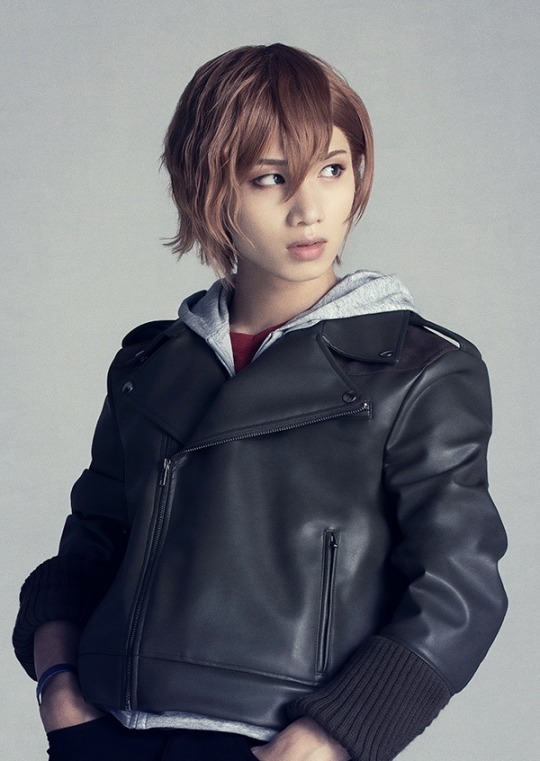




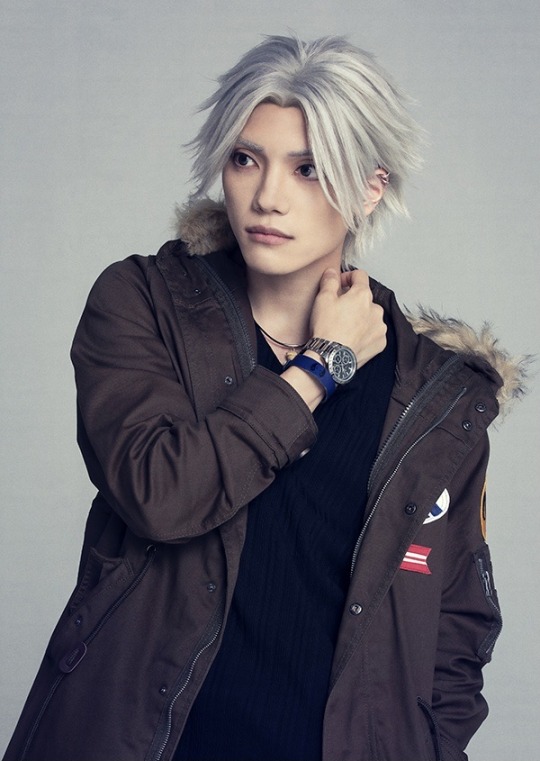
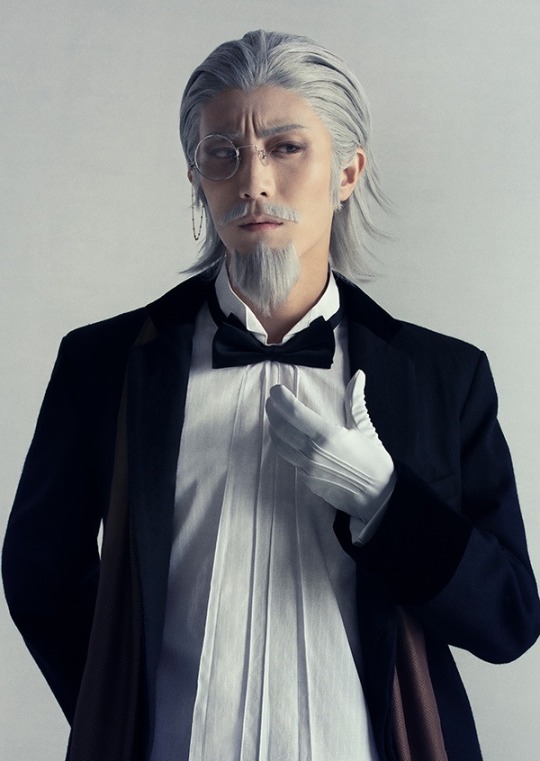
✨Dazai and Chuuya - Fifteen | Stageplay Cast✨
Casting director costume art director appreciation because I literally am gonna die from the beauty of this
I havent even watched the dead apple stage BITCH lemme ✨B R E A T H E✨

#im losing my shit in the middle of a work day dont touch me#randou looks so pretty wtf#bsd#bungou stray dogs#bsd stage#dazai osamu#bsd stage play#chuuya nakahara#ueda keisuke#bsd dazai#bsd chuuya#rui tabuchi#tabuchi rui#bsd mori#bsd kouyou#bsd randou#bsd arthur rimbaud#bsd hirotsu#bsd shirase#hirotaka kato#sera mutsuki#masakazu nemoto#ryujiro izaki#kei hosogai#fifteen stageplay
767 notes
·
View notes
Text
NEWS: Bungou Stray Dogs Fifteen Stage Play Cast and Visual Released








#bungou stray dogs#bsd#bungo stray dogs stage play#bsd fifteen#bsd fifteen stage play#ueda keisuke#rui tabuchi#hirotaka kato#sera mutsuki#masakazu nemoto#ryujiro izaki#kei hosogai#dazai osamu#nakahara chuuya#mori ougai#arthur rimbaud#shirase#ozaki kouyou#hirotsu ryuurou
136 notes
·
View notes
Text
Bungo Stray Dogs on Stage: STORM BRINGER
BSD Stage Official revealed a new visual of the upcoming stage play along with the old & new cast. The play will start on June 24.


Cast: Nakahara Chuya - Ueda Keisuke Paul Verlaine - Sasaki Yoshihide Adam Frankenstein - Isono Dai Shirase - Izaki Ryujiro

Hirotsu Ryuro - Kato Hirotaka Dazai Osamu - Tabuchi Rui Mori Ogai - Nemoto Masakazu N - Kubota Yuki
#bsd storm bringer#bungou stray dogs storm bringer#bsd stage#bungou stray dogs on stage#bungou stray dogs
60 notes
·
View notes
Text
- Tamaki out-princes and flusters Mikorin
- Kashima is thrilled by Tamaki! They proceed to discuss how much they adore and respect their love interests
- Nozaki definitely befriends Mori and answers Kyoya’s questions about how much he makes with his manga and market potential
- Kyoya also sympathizes with Hori about being in charge of a group with an eccentric lead (Haruhi definitely joins this discussion once it moves to the topic of chaotic love interests)
- Chiyo and Waka eat cake with Honey while the twins and Seo commit war crimes
I’ve been binging anime since I actually have time now and I’m rewatching Ouran and I love it but also imagine manga squad meeting the host club
Like Kashima would love Haruhi and Haruhi would think Kashima is exhausting but secretly love her too
#seo and the twins are just humanity's greatest chaotic nightmare waiting to happen#gekkan shoujo nozaki kun#gsnk#ouran high school host club#ohshc#tamaki suoh#mikorin#kashima#nozaki#umetarou nozaki#mori#kyoya ootori#haruhi fujioka#sakura chiyo#hirotaka wakamatsu#hikaru hitachiin#kaoru hitachiin#seo yuzuki
86 notes
·
View notes